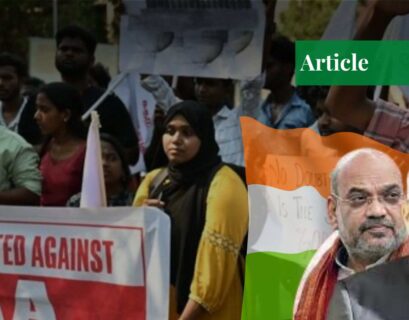Mehmoona Shahzad is pursuing her master's in international relations at National Defence University, Islamabad.
Introduction
Stephen P. Westcott published his book Armed Coexistence: The Dynamics of Intractable Sino-Indian Border Dispute in 2022. He did his doctorate in politics from the University of Murdoch and his master’s in international relations from the University of Western Australia. He is also a postdoctoral research associate at Murdoch University and teaches international relations and global security at the same university. His areas of interest are the Indo-Pacific, South Asian security, geopolitics, and topics related to terrorism and counterterrorism. He is working as an editor of a book review for the Journal of Asian Security and International Affairs.
Why is the Sino-Indian Issue Unresolvable?
Armed Coexistence addresses the boundary disputes between China and India, the two emerging superpowers. The Sino-Indian boundary issue has been an ongoing problem for both nations since their formation. Wescott used Neoclassical realism and three levels of analysis – the individual, domestic, and international levels – to explain why this issue has become and will continue to be unresolvable. Westcott connects this dilemma to Kenneth Waltz’s three-level concept, which breaks down the state into its leaders, institutions of governance, and role as an actor in the global system.
There are three general policies, namely the policies of escalation, compromise, and maintaining the status quo when these levels of analysis are applied to any interstate border issue. While rejecting the strategy of escalation and compromise, China and India both consider the policy of maintaining the status quo. Due to this, the conflict between India and China has remained unresolved despite multiple boundary disputes and rounds of negotiations, and it is likely to persist for the foreseeable future.
Summary
There are seven chapters in the book. Armed Coexistence’s general introduction is covered in the first chapter. The historical context from the British Raj to the contemporary situation is provided in chapter two of this book. This chapter also recounts how the British Empire’s attempts to define the northern border led to the boundary dispute between India and China.
After China’s 1949 revolution and India’s independence in 1947, the border war did not reemerge until the late 1950s, when border guards began to collide. Negotiations quickly became games of cat-and-mouse, which led to the 1962 border confrontation. Border talks started in the 1980s after the Sino-Indian relations thawed in the middle of the 1970s. The chapter then explores the present conflict along the LAC, and how it intensified and set the stage for a fatal conflict in 2020.
The third chapter deals with the issue of why this problem was created and is still present. This chapter discusses the three common policy alternatives for resolving the conflict between both countries: escalation, compromise, or maintaining the status quo. The chapter argues that unresolved border conflicts persist because doing so would be detrimental to the interests of three different stakeholder groups in each state: the state’s specific leaders, its governing bodies, and both states themselves.
The fourth chapter explores why it is typically counterproductive for the top state official to advocate for defusing or escalating a border dispute. It starts by describing how each top executive chooses the strategy they feel to be the best among the options provided using poliheuristic decision theory. According to this idea, a top executive’s decision to implement a program is likely to be influenced by concerns about their political future, unique ideological convictions, or temperament. Because the state’s leader often needs to take a firm stance on the border conflict to maintain their political survival, their interests frequently prevent the prospect of a solution.
The fifth chapter of the book examines how the objectives of domestic governing institutions, including political parties, civil servants, and the role of the military lead to the intractability of interstate border disputes. The chapter demonstrates how these entities interact and affect policymaking using the governmental politics paradigm. Officials from security and diplomatic organizations, as well as the parties in power, frequently compete when considering an interstate border dispute. Since more risk-taking policies can jeopardize their other interests, most actors prefer to keep things as they are.
Even organizations that support compromise or de-escalation frequently do not want to use political resources for the policy. The chapter identifies the important governing bodies in both countries that have an impact on the border dispute policy that is adopted and put into practice. It describes their diverse interests and explains why it is not to their best advantage to endorse a strategy of massive accommodation or escalation on the contentious Sino-Indian boundary, which would keep things as they are and make the conflict unresolvable.
The sixth chapter of Armed Coexistence investigates why it is detrimental to a state’s national interests for it to settle any border issue in which it is involved. Drawing on the neoclassical realist perspective on how strategic culture and context determine a state’s reaction to the international system, three general categories can be recognized as being crucial to the national interest. First, the state’s natural desire is to hang onto valuable land, whether it can be physical or immaterial. Second, there are more general geostrategic considerations. States are mindful of the power dynamics between them and look for ways to take advantage of or use the conflict for their larger diplomatic objectives.
The state’s normative considerations, on which all states place a high value and include perceptions of national prestige and sovereignty, constitute the final consideration. States are encouraged to maintain the status quo and to be strong in border negotiations by these three areas of concern. These issues have various degrees of impact on both states because India and China are both rising powers and there are potential competitors in the international order. Therefore, it has become impossible for either party to settle their border issue for fear of losing a prospective advantage or looking foolish. However, after explaining why the Sino-Indian conflict cannot be resolved, Westcott offered some recommendations for conflict resolution in the last chapter.
Analysis
Armed Coexistence only focuses on the Sino-Indian border dispute and undermines the political and strategic dynamics of South Asia. It ignores other factors like culture and economics that contribute to the stability and security of the region and only focuses on the military aspect of the conflict. It does not explain the impact of the Sino-Indian border dispute on the region’s stability and security and fails to take into consideration the role of key international actors like the major powers and international organizations.
Aside from that, this book takes the readers on a journey from the start of this conflict to the present scenario. In this way, a roadmap develops in the mind of the reader. Westcott explains the whole conflict in the neoclassical paradigm. Westcott tells this event from the standpoint of the individual, the domestic public, and the international level, using Kenneth Waltz’s (1959) three levels of analysis. The first level examines the leaders’ assessments; the domestic level examines which institutions demand approval and input, as well as bureaucracy and political pressure from within; the international level examines a “state’s subjective strategic culture and context.”
He demonstrates, using a neoclassical realist framework, how political fights over prominent stakes take on a life of their own and become greater than particular nations or personalities. They also incorporate domestic public participation and the nature of power in the international system. His framework of border disputes can be applied to other border conflicts as well. Since Armed Coexistence was published in 2022 so it gives insight into the recent developments in the conflict.
If you want to submit your articles, research papers, and book reviews, please check the Submissions page.
The views and opinions expressed in this article/paper are the author’s own and do not necessarily reflect the editorial position of Paradigm Shift.



















